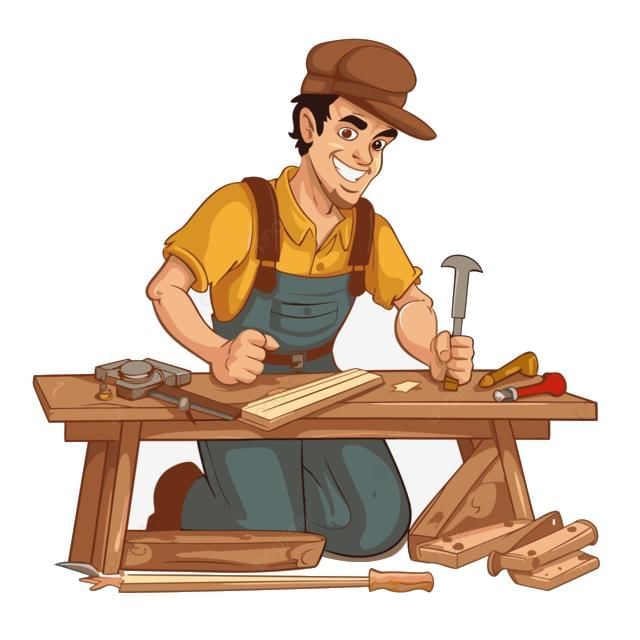Working with Wood and Bamboo Chapter Notes | Technology Grade 9 PDF Download
Introduction
 Wood and bamboo are natural materials widely used in daily life. They are found in homes (doors, windows, furniture), schools (benches, shelves), sports (cricket bats, hockey sticks), tools (handles of utensils), and transportation (boats, carts). Both materials are versatile, durable, and can be shaped into useful products by carpenters and craftsmen. Ancient Indian architecture (like Padmanabhapuram Palace, Hidimba Temple, Rumtek Monastery) demonstrates the long-lasting and artistic use of wood. Even today, wood and bamboo are preferred because they regulate temperature—keeping rooms cooler in summer and warmer in winter.
Wood and bamboo are natural materials widely used in daily life. They are found in homes (doors, windows, furniture), schools (benches, shelves), sports (cricket bats, hockey sticks), tools (handles of utensils), and transportation (boats, carts). Both materials are versatile, durable, and can be shaped into useful products by carpenters and craftsmen. Ancient Indian architecture (like Padmanabhapuram Palace, Hidimba Temple, Rumtek Monastery) demonstrates the long-lasting and artistic use of wood. Even today, wood and bamboo are preferred because they regulate temperature—keeping rooms cooler in summer and warmer in winter.
Importance of Wood and Bamboo
Wood:
- Used for construction, furniture, tools, packaging, paper, and artworks.
- Renewable resource, but overuse without replanting trees leads to deforestation.
- Hardwood (e.g., teak, mango, babool) for strong furniture and structures.
- Softwood (e.g., pine, deodar, eucalyptus) for lightweight items and paper.
Bamboo:
- Technically a perennial grass that regrows quickly after being cut.
- Found in almost all parts of India, especially the North-East.
- Strong, lightweight, and eco-friendly, used for handicrafts, utensils, furniture, and even musical instruments.
Sustainability and Tradition
- Sustainable use means cutting only mature trees or using substitutes like plywood, MDF (Medium Density Fibreboard), or recycled wood.
- Atharva Veda emphasised regeneration and respect for Earth: “Whatever we dig out from you, O Earth! May that have quick regeneration.”
- Bamboo is naturally sustainable because it regrows after cutting.
Tools and Materials Required
Tools
Tri-square, hand saw, wood file, plane, claw hammer, measuring tape, steel ruler, bench vice, clamps, brush, hand drill, cutter.
Materials
Nails, screws, glue, sandpaper, varnish, softwood/bamboo, cardboard, synthetic resin adhesive, cellophane tape.
Safety Measures
- Tool Handling: Use cutting tools carefully; wear masks and goggles to avoid wood dust.
- Workplace Safety: Keep the area clean, store tools properly after use.
- Internet Safety: Use online resources carefully with teacher’s guidance.
Types of Wood
Hardwood: Stronger but harder to cut. Examples:
- Babool, Mango → Construction.
- Jackfruit → Furniture, handicrafts.
- Teak (Sagawan) → Ships, outdoor furniture.
Softwood: Easier to cut and shape. Examples:
- Pine, Deodar → Lightweight furniture, shelves.
- Eucalyptus → Paper.
Fingernail Test: Scratch with nail—if it leaves a mark → Softwood; if not → Hardwood.
Common Joints in Carpentry
- Butt Joint: Simple corner joint for light furniture.
- Lap Joint: Overlapping pieces, stronger than butt joint.
- Mitre Joint: Angled joint at 45°, used in frames.
- Mortise and Tenon: Strongest joint, used in doors, windows, bookshelves.
Other fasteners:
- Nails and Screws: Fixed with hammer or screwdriver.
- Nuts and Bolts: For stronger joins.
- Hinges: For moving parts like doors, lids, cupboards.
Prototyping
A prototype is a small model made before the final product.
Steps:
- Sketch the design with dimensions.
- Collect material (cardboard/softwood).
- Cut and assemble using glue/tape.
Advantages:
- Tests if design is practical.
- Reduces errors before making the real product.
- Saves cost and materials.
Basic Carpentry Skills
Sketching and Planning: Draw design, collect materials.
Measuring and Marking: Mark exact cutting points.
Cutting: Use hacksaw carefully with bench vice.
Sanding: Smooth edges and surfaces with sandpaper.
Planing: Use plane tool to even out rough surfaces.
Drilling: Create holes for screws/nuts.
Assembly: Join parts using joints, nails, or screws.
Finishing: Apply varnish/paint for durability and attractive look.
Working with Bamboo
Parts of Bamboo:
- Culm (hollow stem with nodes and internodes).
- Sheath (protective cover), roots, leaves, rhizome.
Steps to Make a Product:
- Sketch with measurements.
- Cut required parts using hacksaw.
- Smoothen by scraping and sanding.
- Assemble parts with nails/screws/bolts.
- Apply varnish/paint for finish.
Repair and Maintenance
Wooden objects require maintenance:
- Tightening screws/nails.
- Sanding worn parts.
- Painting or varnishing for protection.
- Regular maintenance increases lifespan of wooden items.
Creative Applications
Students can make:
- Wooden objects: coasters, key holders, nameplates, toys, phone stands, bird houses.
- Bamboo products: flutes, baskets, showpieces, utensils.
- Musical instruments: Ektara, damaru, chipli, bamboo flute, wooden drums.
- Waste wood can be reused for shelves, art pieces, or simple gifts.
|
2 videos|86 docs|18 tests
|
FAQs on Working with Wood and Bamboo Chapter Notes - Technology Grade 9
| 1. Why is wood considered an important material for carpentry? |  |
| 2. What are some common types of wood used in carpentry, and what are their characteristics? |  |
| 3. How can bamboo be utilized in carpentry, and what are its benefits? |  |
| 4. What safety measures should be taken when working with wood and bamboo? |  |
| 5. What are some common joints in carpentry, and why are they important? |  |




















